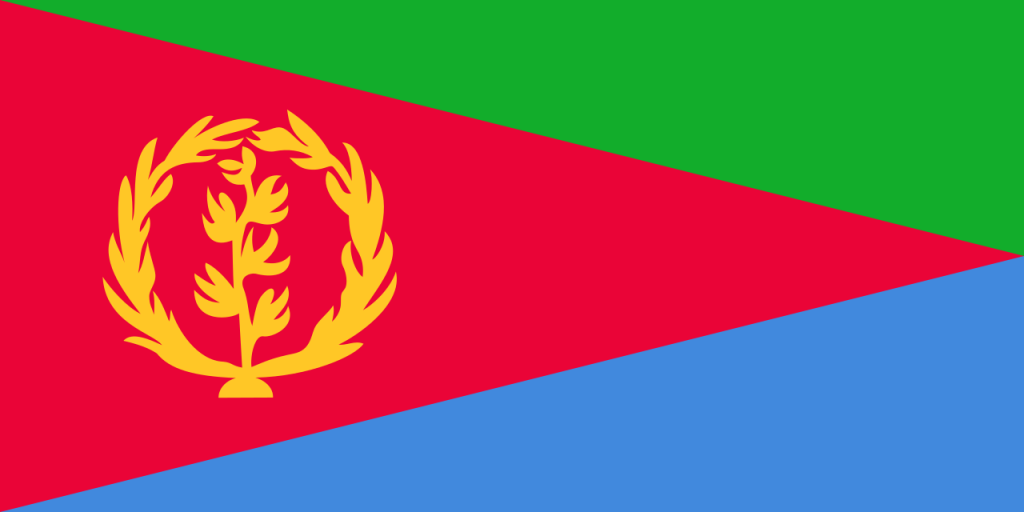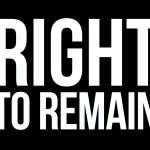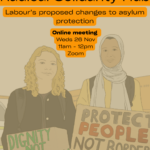The front page news in the Guardian last week, that “Home Office Eritrea guidance softened to reduce asylum seeker numbers” will not surprise those who have been following the debacle of Eritrean asylum claims in the UK for some time.
The Public Law Project managed to obtain internal Home Office documents that evidenced UK government efforts to seek more favourable descriptions of human rights conditions in Eritrea. This evidence confirms what has been clear for some time – that the UK’s priority has been reducing migration, irrespective of the deaths, torture and persecution that might entail.
Back in Refugee Week 2015, Right to Remain joined 500 Eritrean asylum seekers who marched swiftly and beautifully through the streets of Liverpool to protest the UK Home Office’s treatment of their cases.
It seems like a good time to recap on the what has happened over the last couple of years, and what the legal situation is now.
Why do people have to flee Eritrea?
The United Nations Commission for Refugees has described the Eritrean government as engaging in “systemic, widespread and gross human rights violations,” and that the abuses occur in the “context of a total lack of rule of law” with the result that it “is not the law that rules Eritreans, but fear.” Detention, torture and extra-judicial killings are just some of the realities of life in Eritrea, which has a “shoot-to-kill” policy for those trying to flee the country.
Read more in Human Rights Watch 2016 report on Eritrea here.
Home office country guidance
Caseworkers at the Home Office use official country guidance documents to determine asylum cases – whether to refuse them, or whether to grant some form of protection in the UK.
The guidance gives a general picture of the country situation, respect for or breach of human rights, evidence of persecution etc. Using this, the decision maker will consider the testimony given by the asylum seeker and any other evidence they have submitted, and compare it to the circumstances described in the guidance. If the person’s story describes persecution that fits a pattern of persecution that is noted to take place in the country guidance, and that person’s story is found to be “credible”, that person is likely to be granted refugee status.
If the guidance denies the existence of persecution for the type of person or circumstances the asylum seeker describes, they are likely to be refused protection and would have to try and show on appeal (if they have the right to appeal) that either their case involves persecution despite not fitting the general picture described in the guidance, or that the country guidance is flawed.
The Home Office’s 2014 Guidance on Eritrea accepted that the national military service in Eritrea was forced labour, and that evaders and deserters from military service are at risk of persecution if forcibly returned to Eritrea. Illegal exit of Eritrea (barring a few circumstances) was also likely to mean the person was at risk of persecution if returned to Eritrea.
At around this time, the grant rate of Eritrea asylum claims in the UK: at first instance, the Home Office granted refugee protection in 85% of cases.
UK mission to Eritrea
As Sara Palacios Arapiles wrote in her August 2015 blog post for Right to Remain:
On 8 and 9 December 2014 the UK Home Office, in a joint official mission with a UK delegation from the Foreign and Commonwealth Office, visited Asmara (the capital of Eritrea) with the aim to discuss the causes of migration with the Eritrean government. Then, in March 2015, the Home Office issued two official country Guidance reports, namely, Eritrea: National (incl. Military) Service, and Eritrea: Illegal Exit which claim that there are signs of improvement inside the country for potential returnees.
In direct contradiction to the Home Office findings, the Foreign Office, after the joint visit, reported that the Eritrean government made no visible progress both on ‘key human rights concerns’ and ‘regarding the indefinite nature of the ENS [Eritrean National Service].’ One of the members of the Foreign Office highlighted “the impossibility of collecting evidence from inside Eritrea due to the lack of proper access to the country.”
Following this official visit, the UK Home Office issued new country guidance on Eritrea, in March 2015. This reversed the position of the 2014 guidance mentioned above, and claimed that national service was no longer indefinite, no longer equivalent to “forced labour” and therefore did not amount to persecution or degrading or inhuman treatment (the basis on which someone would be granted refugee status or other forms of protection in the UK).
The guidance also argued that Eritreans who had left the country illegally were no longer ‘automatically’ at risk of persecution on return.
The only categories of people that the guidance considered to be at risk of mistreatment on return to Eritrea were those ‘politically active in their opposition to the Eritrean government’ as well as Eritrean conscientious objectors, who are not able to perform military service on account of their religious beliefs.
The Danish report
The March 2015 guidance relied heavily on a discredited report produced for the Danish Immigration Services. The UK Home Office used this report to argue that Eritrea was largely safe and free from persecution.
The Danish report drew fierce criticism from many organisations including the UN refugee agency (UNHCR), Amnesty International and Human Rights Watch. Human Rights Watch pointed out that:
“the authors of the Danish Report did not interview a single victim or witness of human rights violations in Eritrea, including deported failed asylum seekers.”
Gaim Kibreab, an Eritrea expert at London’s South Bank University who was the only source mentioned by name in the report, said his quotes were:
“selectively and misleadingly used with the sole intention of backing up the report’s point of view”.
Three officers from the Danish immigration mission to Eritrea resigned after having denounced the methodology and content of the report on Eritrea. The report was withdrawn by the Danish Immigration Services but despite this, the UK Home Office continued to rely on it to refuse Eritrea asylum claims.
Denying protection
This dramatic change in guidance used by the Home Office was very quickly reflected in the statistics on refusals of Eritrean asylum cases.
The Home Office grant rate of Eritrean asylum cases, previously one of the highest percentages of grant-rates of any nationality (85%) plummeted to 60%.
This didn’t reflect a reduction in risk of persecution, as the asylum appeal success rate in Eritrean cases showed. If an asylum seeker has the right to appeal a Home Office refusal of their asylum case, they will have an appeal hearing at the First-tier Tribunal which is independent from the Home Office.
Nearly 90% of Eritrean asylum appeals heard at the Tribunal were successful – the courts were finding that 9 times out of 10, the Home Office was getting the decision wrong … in life and death cases.
A new UK fact-finding mission to Eritrea went ahead in February 2016. The UK government published its report from this mission and updated its country guidance in August 2016 but without substantially changing its position – it still argued that Eritrea was safe for most people to return to.
As it became clear that a new country guidance case (see below) was to be determined at the Upper Tribunal, the Home Office seemingly held off on making any new decisions on Eritrean asylum cases. Whilst this may have meant that people were not being refused, it also left many Eritreans in limbo for many months – not knowing if they would be allowed to stay in the UK and start to build a new, safe life; or if they would suddenly be refused and face detention and forced removal to the country they had fled.
New country guidance case on Eritrea
Country guidance cases
These are asylum appeals chosen by the immigration/asylum tribunal to give legal guidance for a particular country, or a particular group of people in a particular country. The decisions in these cases are assumed to be based on the best possible evidence about that country at that time. Until there are significant changes in that country, a country guidance decision sets out the law for other asylum-seekers from that country.
A new country guidance case on Eritrea was heard in June 2016 and the judgment was published in October. The case is called MST and Others (national service – risk categories (CG). The (CG) at the end denotes that it is a country guidance case, and therefore carries the weight described above. You can find the judgment here.
As Colin Yeo reported on his Free Movement blog:
The findings are good news for Eritrean refugees seeking sanctuary; the tribunal recognises the danger they face if returned. Almost any Eritrean who reaches the UK is likely to be a refugee given that the conditions of military service are found to amount to cruel, inhuman or degrading treatment and forced labour, those who have evaded that military service are at real risk of additional persecution on return and the categories of person who are permitted to leave lawfully are very narrow.
This appreciation of the dangers in Eritrea contrasts markedly with the Home Office, which in essence wins several procedural battles over the course of the determination but nevertheless comprehensively loses the war.
The judgment is long (459 paragraphs) but if the country guidance case could be useful in your case or that of someone you are supporting it’s a good idea to try and read it all!
Here are the summary of the findings, with emphasis and explanations of complicated bits or legal terminology added by us in italics:
1. Although reconfirming parts of the country guidance given in MA (Draft evaders – illegal departures – risk) Eritrea CG [2007] UKAIT 00059 and MO (illegal exit – risk on return) Eritrea CG [2011] UKUT 00190 (IAC), this case replaces that with the following: [this country guidance case is the current case law on these matters, but some of parts of it just confirm findings in the previous country guidance cases of MA and MO]
2. The Eritrean system of military/national service remains indefinite and since 2012 has expanded to include a people’s militia programme, which although not part of national service, constitutes military service. [The 2015 Home Office country guidance, and the basis of many of its refusals of cases, argued that national service wasn’t indefinite – it included a quotation from the discredited and withdrawn Danish Report that “military/national service lasts for around four years.” and referred to unofficial statements made by the Eritrean President’s Adviser Yemane Gebreab and the Eritrean Foreign Minister Osman Saleh, who ‘promised’ that from November 2014, National Service was to be subject to an 18 month limit.]
3. The age limits for national service are likely to remain the same as stated in MO, namely 54 for men and 47 for women except that for children the limit is now likely to be 5 save for adolescents in the context of family reunification. For peoples’ militia the age limits are likely to be 60 for women and 70 for men.
4. The categories of lawful exit have not significantly changed since MO and are likely to be as follows:
(i) Men aged over 54
(ii) Women aged over 47
(iii) Children aged under five (with some scope for adolescents in family reunification cases
(iiii) People exempt from national service on medical grounds
(v) People travelling abroad for medical treatment
(vi) People travelling abroad for studies or for a conference
(vii) Business and sportsmen
(viii) Former freedom fighters (Tegadelti) and their family members
(ix) Authority representatives in leading positions and their family members
[If you do not fall into one of these categories, it is likely that your exit of Eritrea was illegal – and therefore you may be able to demonstrate you would be at risk of persecution if returned.]
5. It continues to be the case (as in MO) that most Eritreans who have left Eritrea since 1991 have done so illegally. However, since there are viable, albeit still limited, categories of lawful exit especially for those of draft age for national service, the position remains as it was in MO, namely that a person whose asylum claim has not been found credible cannot be assumed to have left illegally. [If the Home Office/courts have found you to be not credible, it might be argued that you can’t prove you don’t fall into one of the legal exit categories. Objective evidence – not just relying on your testimony – will be important in these cases. For example, can you prove your age? Or that you are not exempt from military service? Or that even if you fall within one of the exemptions, meaning that in theory you can leave legally, your exit would still be considered illegal?]
The position also remains nonetheless (as in MO) that if such a person is found to have left Eritrea on or after August/September 2008, it may be that inferences can be drawn from their health, history or level of education or their skills profile as to whether legal exit on their part was feasible, provided that such inferences can be drawn in the light of adverse credibility findings.
For these purposes a lengthy period performing national service is likely to enhance a person’s skill profile. [On the one hand, does your good health suggest that you are unlikely to have been exempted from national service on medical grounds, or be able to get permission to travel abroad for medical treatment? On the other hand, if you’ve already served a long period of national service, you may be more likely to have acquired the ‘skills profile’ needed to get permission to exit legally.]
6. It remains the case (as in MO) that failed asylum seekers as such are not at risk of persecution or serious harm on return. [Being a refused asylum seeker returned to Eritrea does not in itself mean you would be at risk. You would need to demonstrate that you meet one of the criteria (draft evader, illegal exit etc) to put you at risk.]
7. Notwithstanding that the round-ups of suspected evaders (giffas), the “shoot to kill” policy and the targeting of relatives of evaders and deserters are now significantly less likely occurrences, it remains the case, subject to three limited exceptions set out in (iii) below, that if a person of or approaching draft age will be perceived on return as a draft evader or deserter, he or she will face a real risk of persecution, serious harm or ill-treatment contrary to Article 3 or 4 of the ECHR [European Convention on Human Rights. See Right to Remain Toolkit section here]
(i) A person who is likely to be perceived as a deserter/evader will not be able to avoid exposure to such real risk merely by showing they have paid (or are willing to pay) the diaspora tax and/have signed (or are willing to sign) the letter of regret. [The UK Home Office had argued that if Eritreans in the UK had written this letter and paid this tax, then they could return safely. The Tribunal disagrees.]
(ii) Even if such a person may avoid punishment in the form of detention and ill-treatment it is likely that he or she will be assigned to perform (further) national service, which, is likely to amount to treatment contrary to Articles 3 and 4 of the ECHR unless he or she falls within one or more of the three limited exceptions set out immediately below in (iii).
(iii) It remains the case (as in MO) that there are persons likely not to face a real risk of persecution or serious harm notwithstanding that they left illegally and will be perceived on return as draft evaders and deserters, namely: (1) persons whom the regime’s military and political leadership perceives as having given them valuable service (either in Eritrea or abroad); (2) persons who are trusted family members of, or are themselves part of, the regime’s military or political leadership. A further possible exception, requiring a more case specific analysis is (3) persons (and their children born afterwards) who fled (what later became the territory of) Eritrea during the War of Independence. [There are some people who left illegally and would be seen as draft evaders and deserters BUT they are unlikely to face persecution because of the reasons mentioned in this paragraph, therefore won’t be at risk on return, therefore don’t need refugee protection in the UK]
8. Notwithstanding that many Eritreans are effectively reservists having been discharged/released from national service and unlikely to face recall, it remains unlikely that they will have received or be able to receive official confirmation of completion of national service. Thus it remains the case, as in MO, that “(iv) The general position adopted in MA, that a person of or approaching draft age … and not medically unfit who is accepted as having left Eritrea illegally is reasonably likely to be regarded with serious hostility on return, is reconfirmed, subject to limited exceptions…” A person liable to perform service in the people’s militia and who is assessed to have left Eritrea illegally, it not likely on return to face a real risk of persecution or serious harm.
9. Accordingly, a person whose asylum claim has not been found credible, but who is able to satisfy a decision-maker (i) that he or she left illegally, and (ii) that he or she is of or approaching draft age is likely to be perceived on return as a draft evader or deserter from national service and as a result face a real risk of persecution or serious harm. While likely to be a rare case, it is possible that a person who has exited lawfully may on forcible return face having to resume or commence national service. In such a case there is a real risk of persecution or serious harm by virtue of such service constituting forced labour contrary to Article 4(2) and Article 3 of the ECHR.
10. Where it is specified above that there is a real risk of persecution in the context of performance of military/national service, it is highly likely that it will be persecution for a Convention reason based on imputed political opinion. [Read more about the Refugee Convention grounds and inputed political opinion in our Toolkit here]














Very accurate and helpful information than the country information itself.